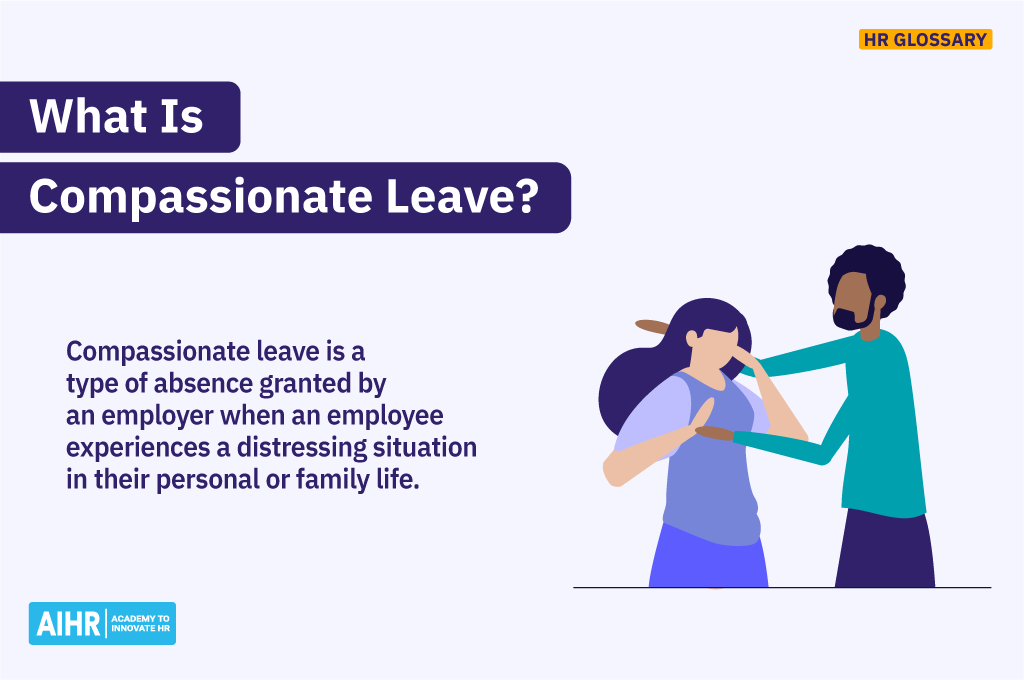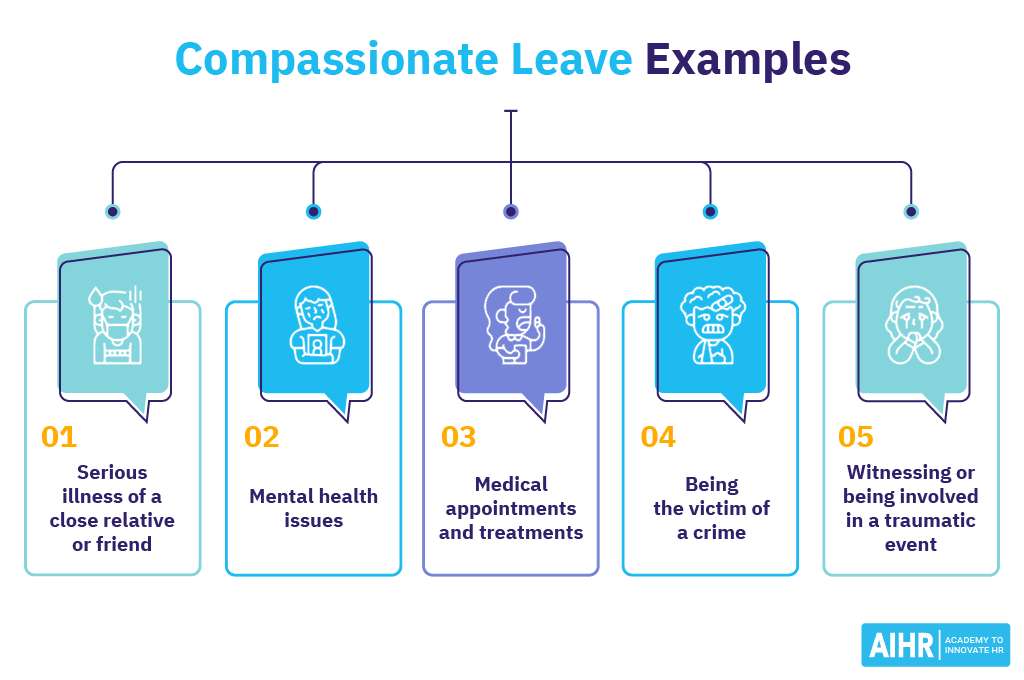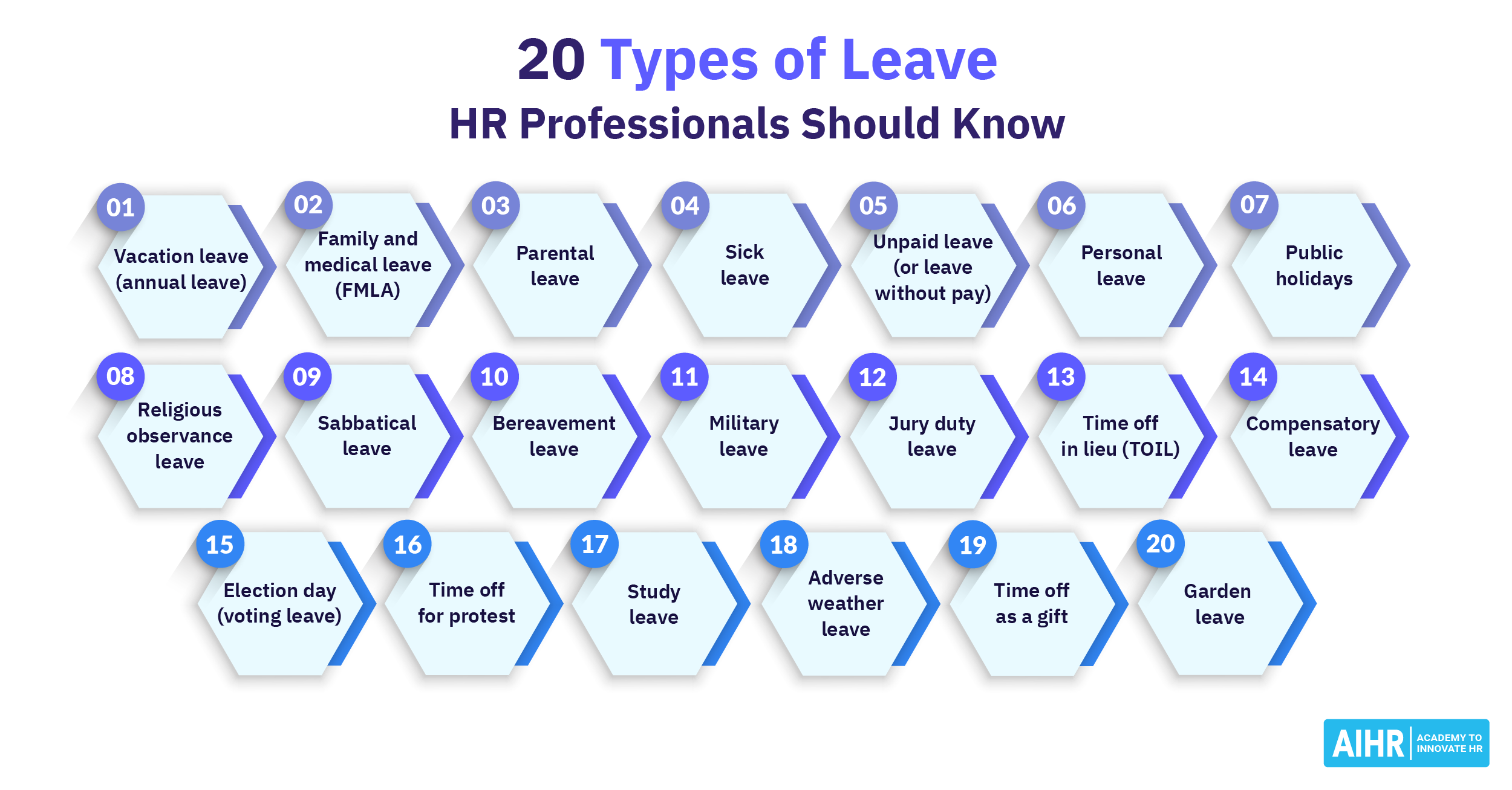Compassionate Leave
What is compassionate leave?
Compassionate leave is a type of absence granted by an employer when an employee experiences a distressing situation in their personal or family life. These circumstances typically include:
- Bereavement: Time off to mourn the death of a close family member or loved one.
- Serious illness of a family member: Time off to care for a seriously ill family member.
- Other personal emergencies: Situations that require the employee’s immediate attention and presence.
Compassionate leave policies vary by country and organization but generally, they allow employees to take a few days off work without fear of losing their jobs. The length of the leave and whether the employee receives pay for the time off depend on their individual circumstances and the employer’s policies.
It’s important for HR to handle compassionate leave requests with sensitivity and empathy, recognizing the emotional and personal stress employees may be experiencing during such times.

Compassionate leave examples
Compassionate leave can be taken for a variety of reasons, including:
- Serious illness or death of a close relative or friend: Employees are often permitted to take time off to care for a seriously ill family member who requires medical treatment or supervision. This could be a few days or weeks, depending on the circumstances. In the case of the death of a close family member or friend, they are usually also allowed to have a few days to a week off to see to funeral arrangements and grieve.
- Mental health conditions: Employees who are dealing with mental health problems might need time off to attend therapy sessions with a psychiatrist or psychologist.
- Medical appointments and treatments: Employees who are undergoing ongoing treatment (such as chemotherapy or physical therapy) may take extended leave, either continuously or intermittently.
- Being the victim of a crime: Victims of domestic abuse, for example, may need time off to find safe housing, meet with police, attend court hearings, or receive counseling support.
- Witnessing or being involved in a traumatic event: Employees who witness or are involved in a traumatic event may take leave to seek treatment and recover.

Is compassionate leave paid?
Whether compassionate leave is paid or not depends on the local laws and the employer’s policies.
In many countries, the law does not mandate the provision of paid compassionate leave, leaving it up to individual companies to decide. Some companies may offer a few days of paid leave, while others might offer unpaid leave or use a combination of paid and unpaid leave. In some places, like the U.K., employees have a right to reasonable time off for emergencies involving dependents — including bereavement — but this is often unpaid unless the employer offers otherwise.
In contrast, Australia includes paid compassionate leave in its National Employment Standards. Full-time and part-time employees are entitled to two days of paid leave per occurrence. Casual employees are also entitled to two days of leave, though this is unpaid. This provision applies each time a family member or someone in their household dies, suffers a life-threatening illness or injury, or if they or their partner experiences a miscarriage.
Singapore has no statutory requirement for employers to provide paid compassionate leave. However, many companies voluntarily offer a few days of paid compassionate leave as part of their employment benefits.
Employees should check their company’s HR policies or employee handbook to understand the specifics of their entitlement regarding compassionate leave.
Compassionate leave vs. bereavement leave
Bereavement leave is a type of leave granted when an employee needs time off due to the death of a loved one. It is often based on an employer policy that may detail specific requirements regarding the relationship between the deceased and the employee.
Compassionate leave, on the other hand, includes a broader range of situations beyond bereavement. Although some employers might use “compassionate leave” and “bereavement leave” interchangeably, it’s essential to recognize that it can cover various circumstances not typically included in a standard bereavement policy.
Overall, both types of leave are used to describe time taken off work for personal reasons. Here is an overview of the key differences between them:
Definition
Leave for personal or family-related emergencies
Leave specifically for grieving and funeral arrangements after the death of a close relative or friend
Scope
Broad; includes illness, injury, and personal crises
Narrow; focused on the death of a close family member or friend
Duration
Flexible; varies based on individual situation and employer policies
Typically short; usually lasts a few days to a week
Payment
Varies; can be paid, unpaid, or require use of another type of leave
May be paid or unpaid depending on the employer’s policy; more commonly paid than compassionate leave
Compassionate leave policy: What to include
As you develop a compassionate leave policy for your company, there are a few key points to keep in mind:
- Define the circumstances that qualify an employee for compassionate leave: While you can leave some room in your policy for exceptions, you should clearly define what type of life events qualify for compassionate leave. This makes it easier for employees to determine when they can request compassionate leave.
- Determine the length of each period of compassionate leave: How long can employees take compassionate leave for each qualifying event? Will this leave be paid, unpaid, or a mix of both? Can employees request an extension if there are further qualifying events or complications? Make sure to include all these details in your policy.
- Outline the request and approval process: Clearly outline the request and approval process for compassionate leave. What steps must the process go through before approval? What qualifying documents does the employee need to provide? It’s essential to keep this process as concise as possible to avoid creating unnecessary barriers for employees who need assistance.
- Specify if the company will offer additional support: Beside time off, your company may want to provide employees with additional support. Offering mental health resources, shortened work days, or more flexibility when the employee returns to work shows the company cares about the employee’s overall wellbeing.
- Explain if other kinds of leave can cover unpaid time off: Include clear guidelines for how employees can use their other types of leave — including PTO and sick leave — to ensure receive pay while on compassionate leave.
HR tip
Offering compassionate leave can go a long way toward improving your overall company culture. Employees are likely to feel a stronger sense of loyalty to a company that stands by them during challenging times, creating a healthy and balanced employee-employer relationship. Additionally, without such leave, employees might not have time to handle personal matters, which can lead to decreased focus and engagement at work.
FAQ
Compassionate leave is a type of leave from work granted to employees to deal with personal or family emergencies, such as the serious illness or death of a close relative or friend. It allows employees time off to manage their emotional wellbeing and make necessary arrangements during difficult times.
The duration of compassionate leave an employer offers can vary depending on the organization’s policies. In general, compassionate leave should include a minimum of three to five days for employees to make necessary arrangements and handle any accompanying challenges.
Whether employees continue to be paid during compassionate leave depends on their employer’s policies. Many organizations offer paid compassionate leave for a few days, with the option for employees to take unpaid leave if they need additional time off. Since compassionate leave is not a legal requirement in many countries, employers can determine how they handle compensation during such periods. However, offering paid compassionate leave can help reduce stress for employees during challenging times and, in turn, improve their relationships with their employers.









